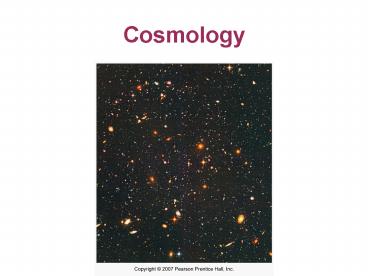Cosmology - PowerPoint PPT Presentation
1 / 21
Title:
Cosmology
Description:
This galaxy map shows the largest structure known in the Universe, the ... The cosmological principle includes the assumptions of isotropy and homogeneity. ... – PowerPoint PPT presentation
Number of Views:142
Avg rating:3.0/5.0
Title: Cosmology
1
Cosmology
2
17.1 The Universe on the Largest Scales
This galaxy map shows the largest structure known
in the Universe, the Sloan Great Wall. No
structure larger than 300 Mpc is seen.
3
17.1 The Universe on the Largest Scales
Therefore, the Universe is homogenous (any
300-Mpc-square block appears much like any other)
on scales greater than about 300 Mpc. The
Universe also appears to be isotropic the same
in all directions. The cosmological principle
includes the assumptions of isotropy and
homogeneity.
4
17.2 The Expanding Universe
Olberss Paradox If the universe is homogeneous,
isotropic, infinite, and unchanging, the entire
sky should be as bright as the surface of the Sun.
5
17.2 The Expanding Universe
So, why is it dark at night? The universe is
homogeneous and isotropic It must not be
infinite and/or unchanging.
We have already found that galaxies are moving
faster away from us the farther away they are
6
17.2 The Expanding Universe
So, how long did it take the galaxies to get
there?
7
17.2 The Expanding Universe
Using
we find that time is about 14 billion years. Note
that Hubbles law is the same no matter who is
making the measurements.
8
17.2 The Expanding Universe
If this expansion is extrapolated backwards in
time, all galaxies are seen to originate from a
single point in an event called the Big Bang. So,
where was the Big Bang? It was everywhere! No
matter where in the Universe we are, we will
measure the same relation between recessional
velocity and distance, with the same Hubble
constant.
9
17.2 The Expanding Universe
This can be demonstrated in two dimensions.
Imagine a balloon with coins stuck to it. As we
blow up the balloon, the coins all move farther
and farther apart. There is, on the surface of
the balloon, no center of expansion.
10
17.2 The Expanding Universe
The same analogy can be used to explain the
cosmological redshift
11
17.2 The Expanding Universe
These concepts are hard to comprehend, and not at
all intuitive. A full description requires the
very high-level mathematics of general
relativity. However, there are aspects that can
be understood using relatively simple Newtonian
physics we just need the full theory to tell us
which ones!
12
17.4 Cosmic Dynamics and the Geometry of Space
- There are two possibilities for the Universe in
the far future - It could keep expanding forever.
- It could collapse.
- Assuming that the only relevant force is gravity,
which way the Universe goes depends on its
density.
13
17.4 Cosmic Dynamics and the Geometry of Space
If the density is low, the universe will expand
forever.
If it is high, the universe will ultimately
collapse.
14
17.4 Cosmic Dynamics and the Geometry of Space
- If space is homogenous, there are three
possibilities for its overall structure - Closed this is the geometry that leads to
ultimate collapse - Flat this corresponds to the critical density
- Open expands forever
15
17.4 Cosmic Dynamics and the Geometry of Space
These three possibilities are illustrated here.
The closed geometry is like the surface of a
sphere the flat one is flat and the open
geometry is like a saddle.
16
17.4 Cosmic Dynamics and the Geometry of Space
In a closed universe, you can travel in a
straight line and end up back where you started.
17
17.4 The Fate of the Cosmos
The answer to this question lies in the actual
density of the Universe. Measurements of luminous
matter suggest that the actual density is only a
few percent of the critical density. But we
know there must be large amounts of dark matter.
18
17.4 The Fate of the Cosmos
However, the best estimates for the amount of
dark matter needed to bind galaxies in clusters,
and to explain gravitational lensing, still only
bring the observed density up to about 0.3 times
the critical density, and it seems very unlikely
that there could be enough dark matter to make
the density critical.
19
17.4 The Fate of the Cosmos
Type I supernovae can be used to measure the
behavior of distant galaxies. If the expansion
of the Universe is decelerating, as it would if
gravity were the only force acting, the farthest
galaxies had a more rapid recessional speed in
the past, and will appear as though they were
receding faster than Hubbles law would predict.
20
17.4 The Fate of the Cosmos
However, when we look at the data, we see that it
corresponds not to a decelerating universe, but
to an accelerating one.
21
17.4 The Fate of the Cosmos
Possible explanation for the acceleration vacuum
pressure (cosmological constant), also called
dark energy.






























![Download Book [PDF] Hawley, J: Foundations of Modern Cosmology PowerPoint PPT Presentation](https://s3.amazonaws.com/images.powershow.com/10050367.th0.jpg?_=20240607117)
![[PDF] DOWNLOAD Rebel Moon: Wolf: Ex Nihilo: Cosmology & Technology (Za PowerPoint PPT Presentation](https://s3.amazonaws.com/images.powershow.com/10071679.th0.jpg?_=20240703032)